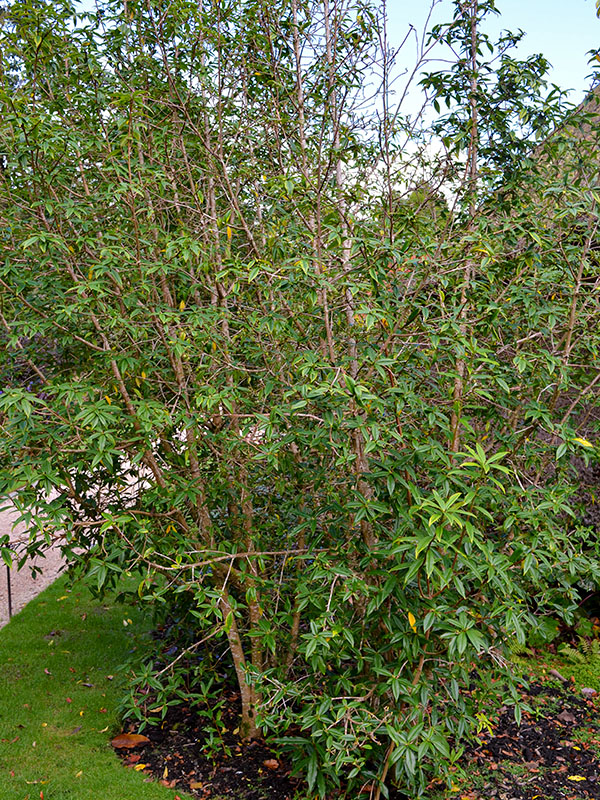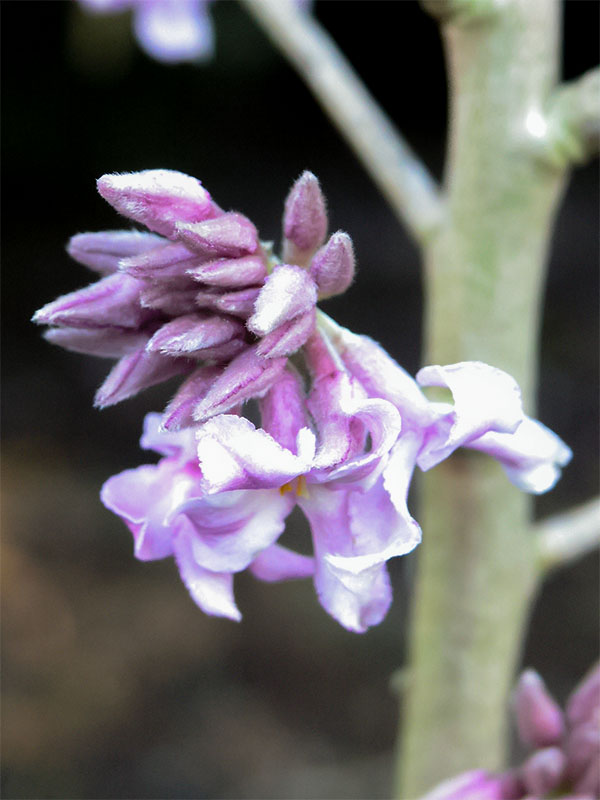
Woody > Daphne > Daphne bholua > Daphne bholua
Daphne bholua
Daphne Bhoula
Origin: In the mountains of Eastern Nepal and China.
Mike's
Opinion


"
The Daphne genus are susceptible to the Daphne Sudden Death Syndrome (DSDS); the plant can die at any time with absolutely no warning. All parts of the plant are toxic if ingested. Some individuals may get a skin irritation if the plant is touched. However D. bhoula is a beautiful plant with a wonderful fragrance and it may be planted in a fragrant border or anywhere in the landscape where its scent may be appreciated. It is not widely available because of hardiness issues in the lower zones of North America.
Michael Pascoe, NDP., ODH., CLT., MSc. (Plant Conservation)
"
| Family |
| Thymelaeaceae |
| Genus |
| Daphne |
| Species |
| bholua |
| Category |
| Woody |
| Type |
| Shrub (deciduous), Shrub (evergreen) |
| Pronunciation |
| USDA Hardiness Zone |
| 7a |
| Canadian Hardiness Zone |
| 6-9 |
| Temperature (°C) |
| 17 |
| Temperature (°F) |
| -17 |
| Height |
| 2.5 m |
| Spread |
| 1.3 m |
Photographs
Description and Growing Information
Flowering Period
| General Description |
| Multi-branched shrub that is found mainly in the mountains of Nepal. It has a wonderful fragrance, with clusters of beautiful white to pale pink flowers. The leaf blades are dull to dark green in colour, and the fruit are inedible and dark purple to black in colour. |
| Landscape |
| Used in the early spring border, edge of patio or garden bed where both its early bloom and fragrance will be appreciated. |
| Cultivation |
| It prefers well drained soils that are slightly acidic but will tolerate alkaline soils. Prefers partial sun to full sun. Daphne bholua grows in soils with a pH of 7 - 8.5. It is suited to, clay loam, loamy sand, sandy clay loam and sandy loam soils, and prefers medium fertility. |
| Shape |
| It has an upright, open form that is many branched. |
| Growth |
| Medium |
| ID Characteristic |
| Usually in mild climates an evergreen shrub with beautiful pale pink flowers that are quite fragrant. Typically an open formed, somewhat unkempt shrub. |
| Pests |
| D. bholua can at times form suckers. When the plant gets a disease it can cause mottling of the foliage. The genus is susceptible to DSDS- Daphne Sudden Death Syndrome. Which is a disease that is brought on by a fungal pathogen that kills the plant without any warning. |
| Habitat |
| Found at elevations between 2438 -3048 m and at lower elevations in the mountains of North Vietnam: higher elevations in China. |
| Bark/Stem Description |
| Rustic brown shade with a rough texture. A side note: is the bark is used to make handmade paper in Nepal, and the inside of the stem is used to make rope. |
| Flower/Leaf Bud Description |
| A medium to large bud that comes to a point at the tip, it is also ribbed around the outer side and is wider at the base. Scaled and plump the bud is about 5-7 mm in length. |
| Leaf Description |
| The leaf is lanceloate in shape with acute apices. The petiole is 1-5 mm long. The size of the leaf is 5 - 17 cm long and 1.7 - 3.2 cm wide. When the foliage gets older, at times it is known to drop off once the plant has bloomed. |
| Flower Description |
| There is a strong scent given off of the flower. The flower is in a cross like shape that is arranged in an umbel of about 8-15 florets, each floret being about 1 cm across. |
| Fruit Description |
| The fruit is black and should not be ingested due to its toxicity. The size of the fruit is 1 cm long and 1 cm wide and is spherical in shape. |
| Colour Description |
| The flowers are white to pale pink, and the leaves are a rich green colour that has a waxy coating. The bark has a rustic brown colour. |
| Notable Specimens |
| Wakehurst Place, Ardingly, West Sussex, England. |
| Propagation |
| The seeds should be warm stratified for 8-12 weeks at 20°C, followed by 12- 14 weeks at 3°C. Germination of this plant can take more than 12 months at 15° C. Pick out the seedlings and place them into individual pots, but only when they are large enough to handle. Keep the plants in the greenhouse through the first winter and then it will be possible to plant them out in the spring once the last expected frost has occurred. |

